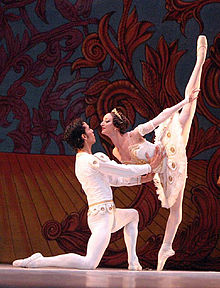

Arabesque (French: [aʁabɛsk]; literally, "in Arabic fashion") in dance, particularly ballet, is a body position in which a dancer stands on one leg–the supporting leg–with the other leg–the working leg–turned out and extended behind the body, with both legs held straight.
In classical ballet, an arabesque can be executed with the supporting leg en pointe or demi pointe or with foot flat on the floor. The working leg may touch the floor in tendu back – an arabesque par terre – or be elevated. Common elevation angles of the raised leg are 45° – à demi hauteur – and 90° – à la hauteur. When the angle is much greater than 90° and the body trunk leans forward to counterbalance the working leg, the position is called arabesque penchée. The arms may be held in various positions.[1] Arabesques are described from the perspective of the dancer, in terms of the stage reference points used by the training system.
- ^ Orthopaedic Section, Performing Arts Special Interest Group (January 1998). "GLOSSARY of DANCE TERMINOLOGY" (PDF). Archived from the original (PDF) on 24 February 2021. Retrieved 13 June 2019.